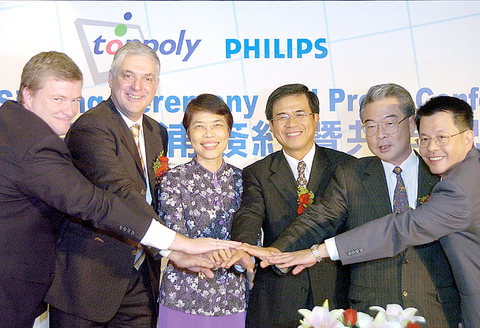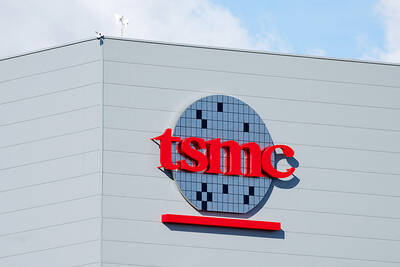Taiwan's Toppoly Optoelectronics Corp (
Toppoly, established in 1999, makes thin-film-crystal (TFT) liquid-crystal-display (LCD) screens used in a wide range of products, including mobile phones, pocket PCs, and displays in cars and notebook computers.
"The merger will give a boost to Toppoly in vying for the top place in the world's small and medium-sized display panels in the long run, after the two companies' customers, technologies and products are integrated," Toppoly chairman Ray Chen (

PHOTO: FANG PIN-CHAO, TAIPEI TIMES
The new entity, renamed TPO, will boost monthly output to around 10 million units of displays sized under 10 inches, from Toppoly's current 3.8 million units, Chen said.
With a combined 11 percent market share, TPO will overtake Japan's Sanyo Epson Imaging Devices Corp as the world's No.3 supplier of the world's small and medium-sized displays, according to statistics provided by market researcher DisplaySearch.
Samsung SDI Co of South Korea occupies the top place in the world's small and medium display market, while Wintek Corp (
Toppoly will issue new shares worth NT$7.4 billion in exchange for Philips Mobile Display System's factories, research division and patents, the company said.
Philips, the world's No.4 supplier of displays in the small and medium-sized segment, will hold 17.5 percent of the new entity, with total capital of NT$42.3 billion, Chen said.
Kinpo Group (
Toppoly expects to wrap up the acquisition in the first half of next year at the latest, after the two companies obtain the approval of shareholders and securities regulators, Chen said.
Chen said Toppoly will start making a profit in the second half of next year after some six years of operation. Toppoly lost NT$2 billion in the first nine months of this year.
Philips' mobile display unit was profitable in the first half of this year with US$400 million in revenue, but swung to losses in the third quarter amid stiff competition, the company said. The unit, headquartered in Hong Kong, has factories in both Shanghai and Shenzhen, as well as Kobe, Japan. It also has a research and development center in Shanghai.
"The deal sounds okay. I think Toppoly is aiming for Philips' customer base, which will help the company deepen its presence in the small-and-medium screen panel market," said Wang Wanli (王萬里), an analyst with Credit Suisse First Boston's local branch.
Customer base is crucial for small-and-medium display makers as the screens are mostly custom-made and qualification procedures take at least six months, Wang said.

Taiwan Semiconductor Manufacturing Co (TSMC, 台積電) secured a record 70.2 percent share of the global foundry business in the second quarter, up from 67.6 percent the previous quarter, and continued widening its lead over second-placed Samsung Electronics Co, TrendForce Corp (集邦科技) said on Monday. TSMC posted US$30.24 billion in sales in the April-to-June period, up 18.5 percent from the previous quarter, driven by major smartphone customers entering their ramp-up cycle and robust demand for artificial intelligence chips, laptops and PCs, which boosted wafer shipments and average selling prices, TrendForce said in a report. Samsung’s sales also grew in the second quarter, up

LIMITED IMPACT: Investor confidence was likely sustained by its relatively small exposure to the Chinese market, as only less advanced chips are made in Nanjing Taiwan Semiconductor Manufacturing Co (TSMC, 台積電) saw its stock price close steady yesterday in a sign that the loss of the validated end user (VEU) status for its Nanjing, China, fab should have a mild impact on the world’s biggest contract chipmaker financially and technologically. Media reports about the waiver loss sent TSMC down 1.29 percent during the early trading session yesterday, but the stock soon regained strength and ended at NT$1,160, unchanged from Tuesday. Investors’ confidence in TSMC was likely built on its relatively small exposure to the Chinese market, as Chinese customers contributed about 9 percent to TSMC’s revenue last

With this year’s Semicon Taiwan trade show set to kick off on Wednesday, market attention has turned to the mass production of advanced packaging technologies and capacity expansion in Taiwan and the US. With traditional scaling reaching physical limits, heterogeneous integration and packaging technologies have emerged as key solutions. Surging demand for artificial intelligence (AI), high-performance computing (HPC) and high-bandwidth memory (HBM) chips has put technologies such as chip-on-wafer-on-substrate (CoWoS), integrated fan-out (InFO), system on integrated chips (SoIC), 3D IC and fan-out panel-level packaging (FOPLP) at the center of semiconductor innovation, making them a major focus at this year’s trade show, according

DEBUT: The trade show is to feature 17 national pavilions, a new high for the event, including from Canada, Costa Rica, Lithuania, Sweden and Vietnam for the first time The Semicon Taiwan trade show, which opens on Wednesday, is expected to see a new high in the number of exhibitors and visitors from around the world, said its organizer, SEMI, which has described the annual event as the “Olympics of the semiconductor industry.” SEMI, which represents companies in the electronics manufacturing and design supply chain, and touts the annual exhibition as the most influential semiconductor trade show in the world, said more than 1,200 enterprises from 56 countries are to showcase their innovations across more than 4,100 booths, and that the event could attract 100,000 visitors. This year’s event features 17